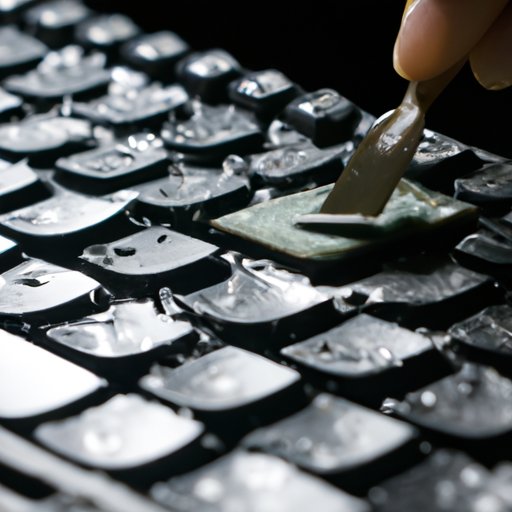
Introduction
Have you ever noticed debris or grime buildup on your laptop keyboard? It’s a common problem for many laptop users, but fortunately, there are easy solutions for regular keyboard cleaning.
Regular keyboard cleaning is essential to maintaining the functionality of your laptop. Not only can a dirty keyboard impact the performance of your device, but it can also harbor bacteria and germs.
In this article, we’ll explore quick and easy cleaning methods, in-depth cleaning techniques for different types of laptop keyboards, DIY solutions for cleaning products, and tips for preventing future debris buildup. We will also provide advice for troubleshooting common keyboard issues and recommended tools for regular maintenance.
Quick and Easy Keyboard Cleaning Method
If you’re looking for a quick and easy way to clean your laptop keyboard, you’ll only need a few common materials: a microfiber cloth, compressed air, and rubbing alcohol.
To start, make sure your laptop is turned off and unplugged. Next, use the compressed air to blow away any debris or dust between the keys. Be sure to hold the canister upright and avoid spraying too close to the keys.
After using the compressed air, dampen a microfiber cloth with rubbing alcohol and gently wipe down the keyboard. Avoid using too much liquid, and be sure to let the keyboard dry before turning on your laptop.
To prevent future debris buildup, consider using a keyboard cover or skin to protect your keyboard.
In-Depth Look: Types of Laptop Keyboards
Not all laptop keyboards are the same. Understanding the type of keyboard you have can help you determine the most effective cleaning technique for your device.
There are three primary types of keyboard mechanisms: mechanical, membrane, and scissor-switch. Mechanical keyboards have individual switches under each key, while membrane keyboards feature a single layer of rubber membrane under the keys. Scissor-switch keyboards use a scissor-like mechanism to connect the key to the underlying structure.
For mechanical keyboards, you can remove the keys to clean underneath. For membrane and scissor-switch keyboards, you’ll want to avoid removing the keys and instead use compressed air to blow away debris between the keys.
If you’re using a membrane keyboard, be sure to use a damp cloth with care. The single rubber layer under the keys is vulnerable to damage from any harsh cleaning materials. For scissor-switch keyboards, be sure to blow away any debris between the scissor mechanism.
DIY Solutions for Keyboard Cleaning
For those looking for a natural cleaning solution, there are several DIY options worth considering, including vinegar, baking soda, and lemon juice. Natural cleaning solutions can be safer for your laptop and more environmentally friendly than store-bought cleaning products.
To make a natural cleaning solution, mix equal parts water and vinegar or baking soda. For lemon juice, mix the juice of one lemon with one cup of water. Dip a microfiber cloth in your solution and wipe down your laptop keyboard. Be sure to let the keyboard dry before turning on your device.
It’s important to note that while natural cleaning solutions are safer for your laptop, they may not be as effective as commercial cleaning products.
Prevention Strategies
Preventing debris buildup on your laptop keyboard is key to maintaining its functionality. There are several best practices to keep in mind, including:
- Keep your hands clean before using your laptop
- Avoid eating or drinking over your laptop
- Regularly clean the surface surrounding your device
You can also use a keyboard cover or skin to reduce the amount of debris that sticks to your keyboard. These covers can be removed and washed, making them easy to maintain.
Troubleshooting Common Keyboard Issues
If you’re experiencing issues with your laptop keyboard, there are several solutions to consider. If your keys are sticky or responding sluggishly, try wiping down the keyboard with a damp cloth or compressed air. If certain keys aren’t working at all, try removing and cleaning the affected keys with a damp cloth.
After extensive cleaning, the keys on your laptop may slide around or feel loose. If this is the case, you can carefully secure the keys back into place.
Recommended Tools for Keyboard Cleaning
If you’d like to invest in a specialized cleaning product, there are several options to choose from, including canned air, keyboard cleaning putty, and cleaning kits.
Canned air is a reliable and affordable option for blowing away debris between your laptop keys. Keyboard cleaning putty is a reusable and non-toxic option that can easily pick up debris between the keys. Cleaning kits often come with a set of cleaning tools, including brushes and wipes, to help you effectively clean your keyboard.
Conclusion
Regular maintenance of your laptop keyboard is key to maintaining its functionality and longevity. By implementing the tips and solutions we’ve provided, you can keep your laptop keyboard clean and free of debris. Whether you prefer a quick and easy cleaning method or DIY solutions, make sure to take care of your keyboard.





